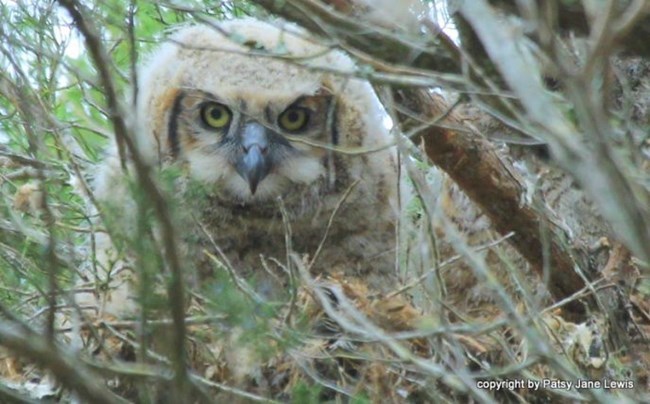
Photo by Patsy Jane Lewis The scientific name of the native and adaptable great horned owl is Bubo virginianus. These owls breed throughout the United States, except in the arctic. They are not particular about nesting tree types or species of tree. Their nests are not elaborate, sometimes consisting of nothing more than a flattened branch ringed with feathers, moss, and ferns; the remains of an old squirrel nest; or a tree cavity. Great horned owls mate for life, and are permanent residents of their territories (at least in Florida, which has an ample prey base all year long). Courtship hooting begins in November, and breeding usually occurs in late December. The female usually lays one or two eggs per clutch and incubates them for an average of thirty-three days. Both parents feed the young, which venture out along the branch away from the nest at five to six weeks after hatching, and fly about a week later. The parents continue to help feed and look after the young owls until they can successfully hunt on their own. By the time of the next breeding season in October the juveniles will fly off to establish their own territories. (Great horned owl territories range from a third to two square miles in size.) Great horned owls are excellent nighttime hunters because they can see well in low light, and have binocular vision which can gauge depth. They swoop down from high perches, catching and crushing prey (usually medium-sized mammals, birds, and lizards) in their talons. They eat their prey whole, later regurgitating undigested bone and fur as "owl pellets" that can be found on the ground near owl nests. Adult great horned owls have no real predators, but they may be killed in fights with eagles or other owls, or by collisions with moving automobiles. Eggs and young may be preyed upon by feral cats. In the wild this owl species can live up to thirteen years. While not the largest owl in North America, the great horned owls' wingspan ranges from forty to sixty and a half inches across, with females being generally larger than males. Their distinctive namesake, their "horns", are actually just tufts of facial feathers that help funnel sounds to their ears. Whether the owl couple of Fort Matanzas (Pa and Ma Tanzas?) decide to nest publicly again or not, the park will continue to provide feeding and nesting habitat for them and all the other avian species that inhabit this part of Florida on a temporary or permanent basis. |
Last updated: April 9, 2020
